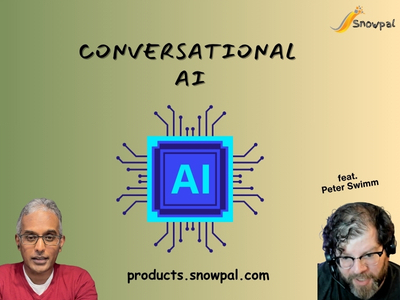Conversational AI (feat. Peter Swimm)
Conversational AI is transforming business interactions. AI tools need to be accessible to everyone to bridge societal gaps. Organizations must adapt to leverage AI effectively.
In this conversation, Krish Palaniappan and Peter Swimm, Founder of ToilVille, explore the evolving landscape of conversational AI and its implications for business, creativity, and society. They discuss the challenges and opportunities presented by AI, particularly in the context of team dynamics, productivity, and the future of work. The conversation also touches on the importance of context in AI applications, the potential for AI to enhance creativity, and the societal disparities in AI adoption. Peter shares insights from his experience in the field, emphasizing the need for organizations to adapt and leverage AI effectively to remain competitive.
Takeaways
Conversational AI is transforming business interactions.
AI can enhance productivity but requires careful implementation.
The future of work will involve collaboration between AI and humans.
Creativity remains a uniquely human trait despite AI advancements.
AI tools need to be accessible to everyone to bridge societal gaps.
Context is crucial for effective AI applications.
AI can tailor education to individual needs.
The disparity in AI adoption is a growing concern.
Innovation requires diverse perspectives and collaboration.
Organizations must adapt to leverage AI effectively.
Podcast
Summary
🎙️ 1. Introduction
Peter discusses his background and how hard it still is to build production-ready conversational AI systems.
🧠 2. Conversational UI vs Conversational AI
Krish introduces the mix-up in terminology between UI and AI.
Peter explains that AI only does what it’s told, lacking human nuance and emotional intelligence.
Challenges of user frustration when AI doesn’t interpret user intent well.
🔄 3. Evolution of Use Cases
Peter shares how conversational AI used to be limited to scripted tasks (like onboarding), but now it’s being used for complex reasoning-based tasks.
Example: AI assistant tracks meetings, emails, and contracts to ensure consistency.
🧾 4. Meeting Transcription & Automation
Krish recaps the example: AI records a meeting, transcribes it, and updates systems like wikis.
Peter elaborates how modern AI tools can:
Distinguish between speakers,
Extract key points,
Connect to organizational data to enrich summaries with context.
🧠 5. Contextual Intelligence in AI
AI needs more than just audio/text—it needs access to organizational and role-based context to summarize effectively.
Discussion on how meetings could auto-generate specs, tasks, and stakeholder-specific summaries.
🔄 6. Workflow Transformation with AI
Krish shares a real-world story: AI → meeting → transcript → GitHub tickets → Copilot-generated code → prototype.
Peter reflects on how this shortens dev cycles and helps teams visualize faster.
👥 7. Changing Team Structures
Discussion about team compositions evolving:
Smaller, more flexible teams.
AI as a force multiplier: “10 people can now do the job of 2–3” or “100 can drop to 10–15”.
Emphasis on cross-functional skills, but also retaining the value of specialists.
📉 8. Workforce Decimation or Efficiency?
Can drops in team size (e.g. 60 to 8) be blamed on prior inefficiency or newfound productivity?
Peter explains that enterprise teams often waste time on coordination.
Small teams with AI can outperform large bureaucratic ones by focusing on outcomes.
🔧 9. Role of Tools & Cultural Context
AI success depends on:
End-user needs (PM vs dev vs sales),
Tooling infrastructure (Jira, Asana, GitHub),
Company culture and structure (startup vs enterprise, East vs West).
🍎 10. Apple & the Challenge of AI
Krish reads an article about Apple’s AI uncertainty and reliance on 3rd-party models.
Peter reacts with insights into Apple’s design-first culture and its friction with engineering goals.
AI adoption requires balancing quality control vs speed to market.
🔮 11. Enterprise Risk & Adoption Levels
Peter describes how most enterprises still rely on AI for safe tasks (FAQs, meeting notes) and don’t trust it yet for live code or production decisions.
Success depends on comfort level, industry, and use case specificity.
Transcript
Snowpal Products
Backends as Services on AWS Marketplace
Mobile Apps on App Store and Play Store
Web App
Education Platform for Learners and Course Creators



